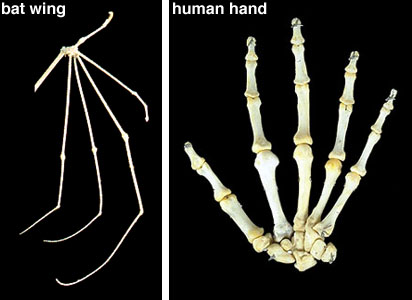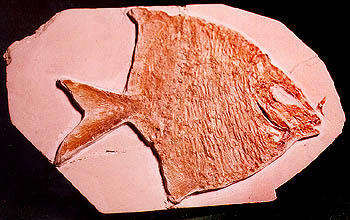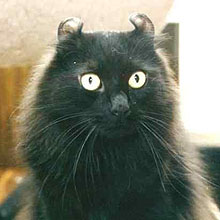- Different organisms may have structures that may have very different functions, but that have the same or similar forms. Such structures indicate descent from a common ancestor.
- Example: Compare this bat's wing bones (left) with human hand bones (center)
and seal flipper bones (right).
You can match each bone in one with a corresponding bone in the other.

Homologous structures: hand bones in bats and humans - Why should you, a bat, a mole, and a whale have identical arrangements
of limb bones, yet do such radically different things with your limbs?
- Embryology
- There are patterns of similarities and differences between the embryonic stages of animals.
- Example: All vertebrate embryos, including humans, pass through a stage with slits in the throat region (pharyngeal clefts, a cartilage rod supporting the spinal cord, and a post-anal tail. Yes, you had pharyngeal clefts (not "gills", although they're sometimes called that) and a tail, once. I presume that you lost them during development. I know I did.
- Why should such similarities exist?
- Biogeography
- You got a taste of this when I discussed South America. . .
- Briefly: Similar-looking species tend to be found near each other -- or in places that were once near to each other.
- The fossils of a continent often have an eerie similarity to the living things on the same continent. Example: South American armadillos, sloths.
- Even isolated places like the Galapagos Islands tend to have animals and plants that resemble those of the nearest continent -- but with differences.
- Why shoudl this be the case?
- Fossils
- As we discussed, a fossil is any trace of a once-living organism. Many fossils are "turned to stone" or otherwise chemically changed, but they don't necessarily have to be.
- Not all fossils are as spectacular as this 20 million-year-old fish. . .

A beautifully preserved fish from the rocks of Monte Bolca, ItalyHowever, each fossil is a piece of direct evidence for some past life form.
- Many fossils seemed to show "blends" or "mixtures" of features that today would be found in very different, separate kinds of organism. Why should that be the case?
- Vestigial Structures
- Vestigial structures have no particular function in an organism -- but they resemble structures that do function in other organisms.
- Example: Mammals have muscles that move their ears, and these function to swivel the ears around in order to detect sound more accurately. (You know this if you've ever seen a dog prick up its ears.)
- Humans have muscles that wiggle their ears, too! But they don't help you pick up sound, and they don't help or hurt your survival in any way. In fact, most of us can't use our ear-wiggling muscles at all.
- What are these muscles doing there?
- Charles Darwin did two things: he made the strongest case yet that
evolution had happened. . . and he spent over twenty years accumulating evidence for a
theory of how evolution, which he published in 1859 in his book
The Origin of Species (which you can read
here).
- Natural populations have the potential to increase their numbers very rapidly.
- But populations sizes in the wild remain relatively steady.
- Conclusion: In each generation, many individuals -- perhaps most of them -- must fail to reproduce.
- Individuals in a population differ from each other in their ability to obtain resources, avoid predators, withstand environmental extremes, find mates, and so on.
- Conclusion: Those individuals with the greatest ability to reproduce successfully will leave the most offspring. This is natural selection.
- Some of the variability in a population can be inherited, and will be passed on from parent to offspring.
- Conclusion: Over many generations, the population changes. This is evolution by natural selection.
- Natural selection is a close analogue to the artificial selection
carried out by plant and animal breeders.
- A breeder consciously chooses which animals or plants will be allowed
to breed -- only those with the features that the breeder wants to develop.
- EXAMPLE: In 1981, a stray cat was found in southern California who had a feature no one had ever seen before: curled ears.
- The couple who found the cat adopted her, bred her instead of spaying her,
picked out the curliest-eared offspring for the next generation, and have
produced a new breed of cat (American Curl).

An American Curl cat. Here's the full story. . . - Charles Darwin himself was a breeder of fancy pigeons, and so had direct experience with what artificial selection was capable of doing -- very different-looking pigeon varieties have been created by breeders in only a few centuries by artificial selection.
- Artificial selection on the wolf-like ancestors of domestic dogs has produced everything from dachshunds to chihuahuas to cocker spaniels to Great Danes. . .
- Artificial selection on the wild cabbage plant has produced domestic cabbage, broccoli, cauliflower, and Brussels sprouts. All of these vegetables are different domesticated strains derived from one wild species.
- Important: Humans don't create variation by artificial selection! Selection only works on variation that's already there.
- A breeder consciously chooses which animals or plants will be allowed
to breed -- only those with the features that the breeder wants to develop.
- One other aspect of selection that Darwin proposed is sexual
selection.
- In sexual selection, the agent that determines which traits are passed on, and which are not, is mate choice.
- If organisms of a certain species prefer mates with a certain trait, that trait will become more common in a population -- those who have it will pass on their genes, and those that don't, won't.
- Often, but not always, female choice acts as a selective agent on males. Examples: Male songbird songs, male guppy colors, male peacock tails, etc.